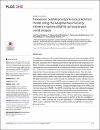Asymptotic BER analysis of FSO with multiple receive apertures over M-distributed turbulence channels with pointing errors
Abstract
In this paper, we consider a free-space optical (FSO) communication with multiple receive apertures over M-distributed turbulence channels with pointing errors. In particular, we consider two different combining schemes at the receiver: optimal combining (OC) and selection combining (SC). With these setups, the statistic characters of the instantaneous electrical signal-to-noise ratio (SNR) are derived. Then, using the cumulative density function (CDF)-based method, we analyze the asymptotic bit-error rate (BER) performance. The derived results help quantifying the diversity order of our considered systems.
Collections
- Electrical Engineering [2850 items ]
Related items
Showing items related by title, author, creator and subject.
-
On the Error Performance of Non-orthogonal Multiple Access Systems
Almohamad A.; Althunibat S.; Hasna , Mazen; Qaraqe K. ( IEEE Computer Society , 2020 , Conference)Unlike orthogonal multiple access schemes, non-orthogonal (NOMA) ones have arisen as an appealing solution to meet the requirements of the upcoming era of massive connectivity. In NOMA schemes, users are allowed to ... -
Average ber of multihop communication systems over fading channels
Hasna , Mazen ( IEEE , 2003 , Conference)Multihop transmission is a way to attain broader coverage by splitting the communication link from the source to the destination into several, possibly shorter links/hops. This paper presents an expression for the moment ... -
A reservoir bubble point pressure prediction model using the Adaptive Neuro-Fuzzy Inference System (ANFIS) technique with trend analysis
Alakbari, Fahd Saeed; Mohyaldinn, Mysara Eissa; Ayoub, Mohammed Abdalla; Muhsan, Ali Samer; Hussein, Ibnelwaleed A. ( Public Library of Science , 2022 , Article)The bubble point pressure (Pb) could be obtained from pressure-volume-temperature (PVT) measurements; nonetheless, these measurements have drawbacks such as time, cost, and difficulties associated with conducting experiments ...


